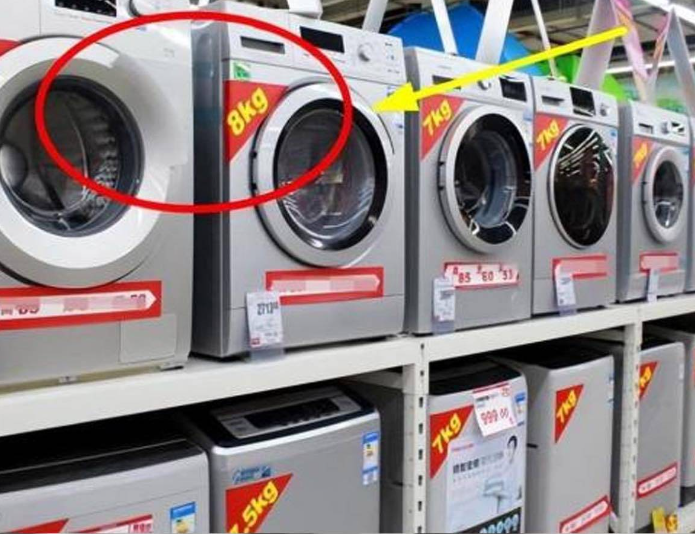Today, as washing machines have become a staple in our households, many of us rely on them to handle our laundry needs. But a common question persists: does the weight capacity shown on a washing machine refer to the weight of dry clothes or wet clothes? Understanding this is crucial to prevent overloading the machine and to ensure that your laundry gets thoroughly cleaned each time.
Let’s break down what washing machine capacity means, how it affects your laundry results, and why it’s essential to load your machine correctly.

What Does the Weight Capacity on a Washing Machine Represent?
When you purchase a washing machine, you’ll notice that it’s labeled with a weight capacity, such as 7kg, 8kg, or 10kg. But what does this number actually mean? Contrary to what some might assume, the stated weight capacity refers to the weight of dry clothes that can be safely loaded into the machine before starting a wash cycle.
For example, a washing machine with a 7kg capacity is designed to handle up to 7kg of dry clothing in a single load. This capacity represents the maximum weight the machine’s motor and drum can effectively handle without risking wear and tear or damage. Loading beyond this limit can lead to issues with the motor, drum, and washing efficiency.
Why Does the Capacity Only Apply to Dry Clothes?
You may wonder why the capacity is specified for dry clothes and not wet clothes, considering clothes become much heavier when soaked with water. The reason is simple: washing machines are designed to add a specific amount of water to the drum based on the dry weight of the load. During the wash cycle, clothes will absorb water, increasing their weight, but this is already accounted for in the machine’s design and programming.
Manufacturers use the dry weight standard because it’s a consistent, measurable starting point for consumers. Attempting to measure clothes while wet would make capacity guidelines confusing and impractical, as the weight of wet clothes varies depending on fabric type, water absorption, and wash settings.
The Consequences of Overloading Your Washing Machine
If you exceed the specified dry weight limit for your machine, it can lead to several issues, including:
- Overheating the Motor: The motor must work harder to spin a heavier load, leading to overheating and potential long-term damage.
- Reduced Washing Efficiency: Overloaded clothes don’t have enough space to move around, reducing friction and leading to less effective cleaning.
- Premature Wear on Parts: Excessive weight can strain the drum, suspension, and bearings, increasing wear and the likelihood of breakdowns.
- Poor Rinse Quality: Overloading can also prevent proper rinsing, leaving detergent residue on clothes that can be irritating to the skin.
To ensure optimal performance, stick to your machine’s capacity by weighing your clothes if possible or estimating using an online guide. If your machine has a 7kg capacity, avoid loading more than 7kg of dry laundry into the drum.
Does Underloading Your Washing Machine Improve Cleaning Results?
Some people assume that washing fewer clothes than the machine’s capacity will yield better results. While this might seem logical, underloading your washing machine can actually lead to inefficiencies. Here’s why:
- Lack of Fabric Friction: Washing machines rely on friction between clothes to help remove dirt. If there are too few items in the drum, they won’t rub against each other effectively, leading to a less thorough clean.
- Waste of Water and Energy: Washing a single shirt or just a few socks in a large-capacity machine will still require the machine’s minimum water level, wasting water and electricity without delivering any added benefit.
- Potential Imbalance: Underloading can sometimes cause the load to become unbalanced, especially if it includes heavy or uneven items like towels or sheets, which can hinder the spin cycle.
For optimal cleaning, it’s best to fill the washing machine to about two-thirds of its capacity. This level ensures there’s enough room for the clothes to move and rub against each other, enhancing cleaning effectiveness while also conserving water and energy.

How to Determine the Ideal Load for Your Washing Machine
To get the best performance from your washing machine, follow these tips when loading it:
- Use the Two-Thirds Rule: Aim to load your washing machine to around two-thirds of its stated capacity. For example, a 7kg machine will perform best with roughly 4-5kg of dry clothes.
- Balance Heavy and Light Items: Avoid washing heavy items like towels or jeans with very light fabrics. Balancing weight within each load helps improve washing performance and prevents damage to delicate fabrics.
- Distribute Clothes Evenly: When loading, place clothes evenly around the drum to prevent the load from becoming unbalanced. This practice improves spin efficiency and prevents damage to the drum.
- Check Labels for Washing Guidance: Some fabrics, like wool or delicate synthetics, may need a different wash cycle or reduced capacity. Checking labels can help you determine the best approach.
Understanding Different Fabric Types and Their Impact on Load Capacity
Various fabric types have different water absorption levels, affecting the wet weight of the load. Here’s a quick guide on common fabrics and how they impact load balance:
- Cotton: Cotton absorbs a significant amount of water, which can increase its weight by up to 70% when wet. Always keep cotton-heavy loads within the machine’s dry capacity.
- Synthetic Fabrics: Polyester, nylon, and other synthetic materials absorb less water, so they won’t add as much weight when wet. However, they are often washed with delicates, which may require a lighter load.
- Wool and Delicates: These fabrics are sensitive to weight and heat, and most machines recommend using reduced capacity when washing delicates. For instance, a 7kg machine may only allow 2-3kg of wool or delicate items at a time.
By understanding fabric types and their water absorption properties, you can make more informed choices about load size and balance.

Tips for Maximizing Washing Machine Efficiency
To keep your washing machine performing at its best and ensure your clothes get a thorough clean, consider these additional tips:
- Use the Right Detergent Amount: Excess detergent can lead to soap residue, while too little won’t clean effectively. Follow detergent guidelines for the best results.
- Run Regular Maintenance Cycles: Washing machines require occasional maintenance to clean out detergent buildup and prevent odors. Use a hot cycle with a washing machine cleaner every few months.
- Choose Appropriate Wash Cycles: Different cycles are designed for different types of loads, so choose the appropriate cycle for each wash to optimize both cleaning power and energy efficiency.
Conclusion
When it comes to washing machine capacity, the weight limit refers to dry clothes only. Understanding this distinction is crucial to avoid overloading your machine and compromising its performance. While you might be tempted to wash fewer clothes than your machine’s capacity for a better clean, a lightly loaded machine can waste water and electricity without improving results. The ideal approach is to load your washing machine to about two-thirds of its dry weight capacity, allowing clothes enough room for movement while ensuring maximum cleaning power.
By following these guidelines, you’ll not only extend the life of your washing machine but also achieve consistently cleaner, fresher laundry every time. So the next time you load up the drum, remember: dry weight is what matters, and balance is key for the best results.


